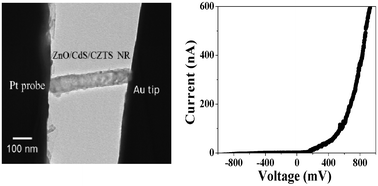Fabrication of ZnO/CdS/Cu2ZnSnS4 p–n heterostructure nanorod arrays via a solution-based route†
Abstract
ZnO/CdS/Cu2ZnSnS4 p–n heterostructure nanorod arrays were fabricated through a novel solution-based method using ZnO nanorod arrays as the template. Typical ZnO/CdS/Cu2ZnSnS4 heterostructure nanorod arrays consist of ZnO/CdS core/sheath nanorods and Cu2ZnSnS4 nanocrystallines grown on the primary ZnO/CdS core/sheath nanorods. In the ZnO/CdS/Cu2ZnSnS4 heterostructure nanorods arrays, ZnO core and CdS sheath are single crystalline, while Cu2ZnSnS4 nanoparticles are polycrystalline. The possible formation mechanism of ZnO/CdS/Cu2ZnSnS4 heterostructure nanorod arrays is also discussed in detail. The ZnO/CdS/Cu2ZnSnS4 heterostructure nanorod arrays possess a broad and enhanced optical absorption from the ultraviolet to the near-infrared region. A good rectification characteristic is observed in the I–V curve of ZnO/CdS/Cu2ZnSnS4 nanorod, which confirms that the ZnO/CdS/Cu2ZnSnS4 nanorod is a p–n heterostructure. Micro-Raman spectroscopy was used to investigate the vibrating properties of ZnO/CdS/Cu2ZnSnS4 heterostructure nanorod arrays. The results indicate that the ZnO/CdS/Cu2ZnSnS4 p–n heterostructure nanorod arrays may shed light on new opportunities for nanoscale optoelectronic devices.


 Please wait while we load your content...
Please wait while we load your content...